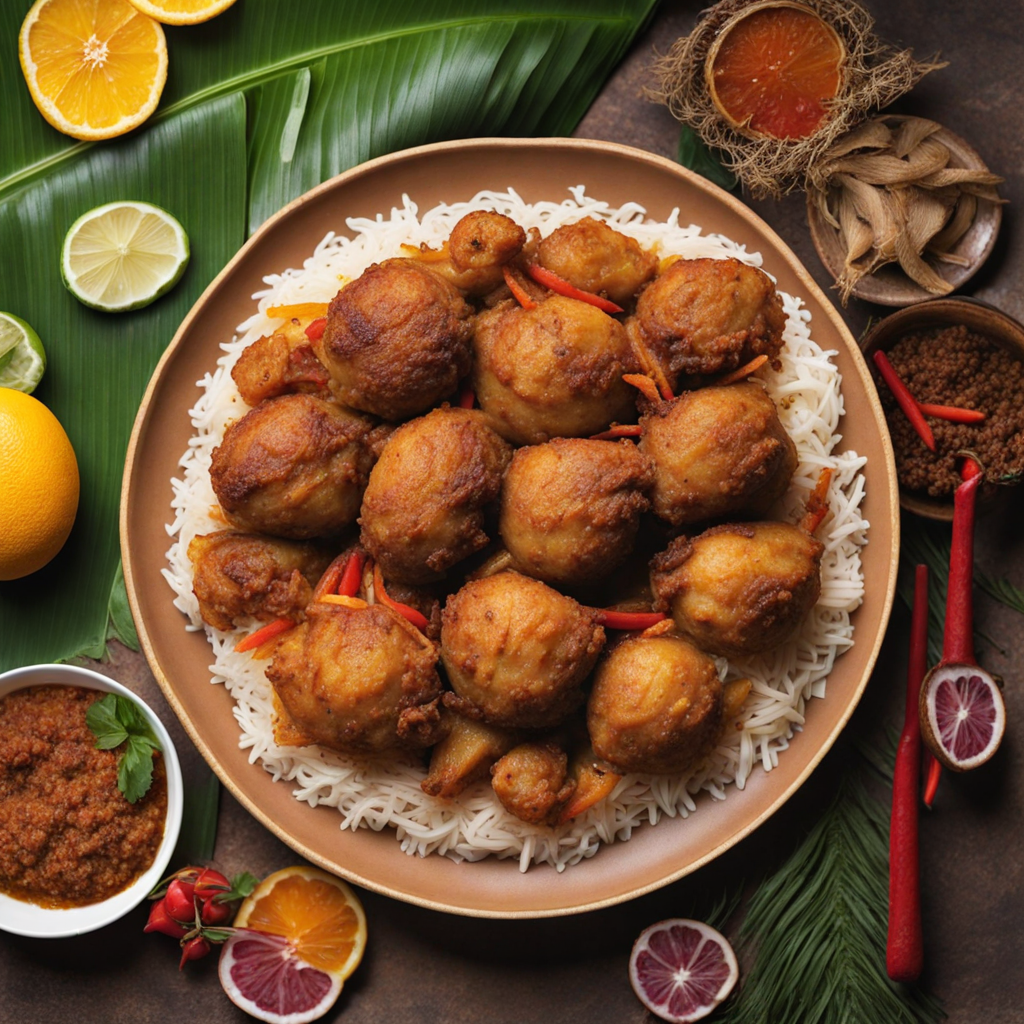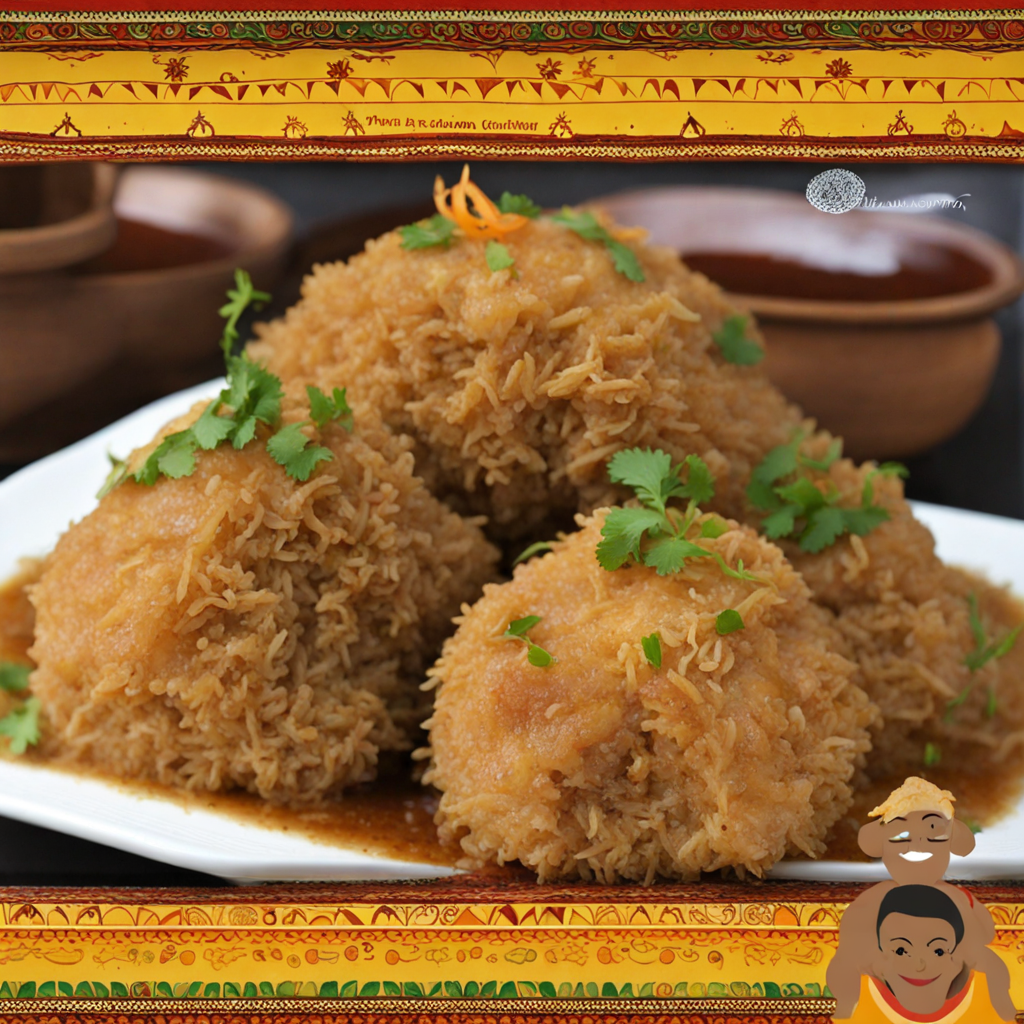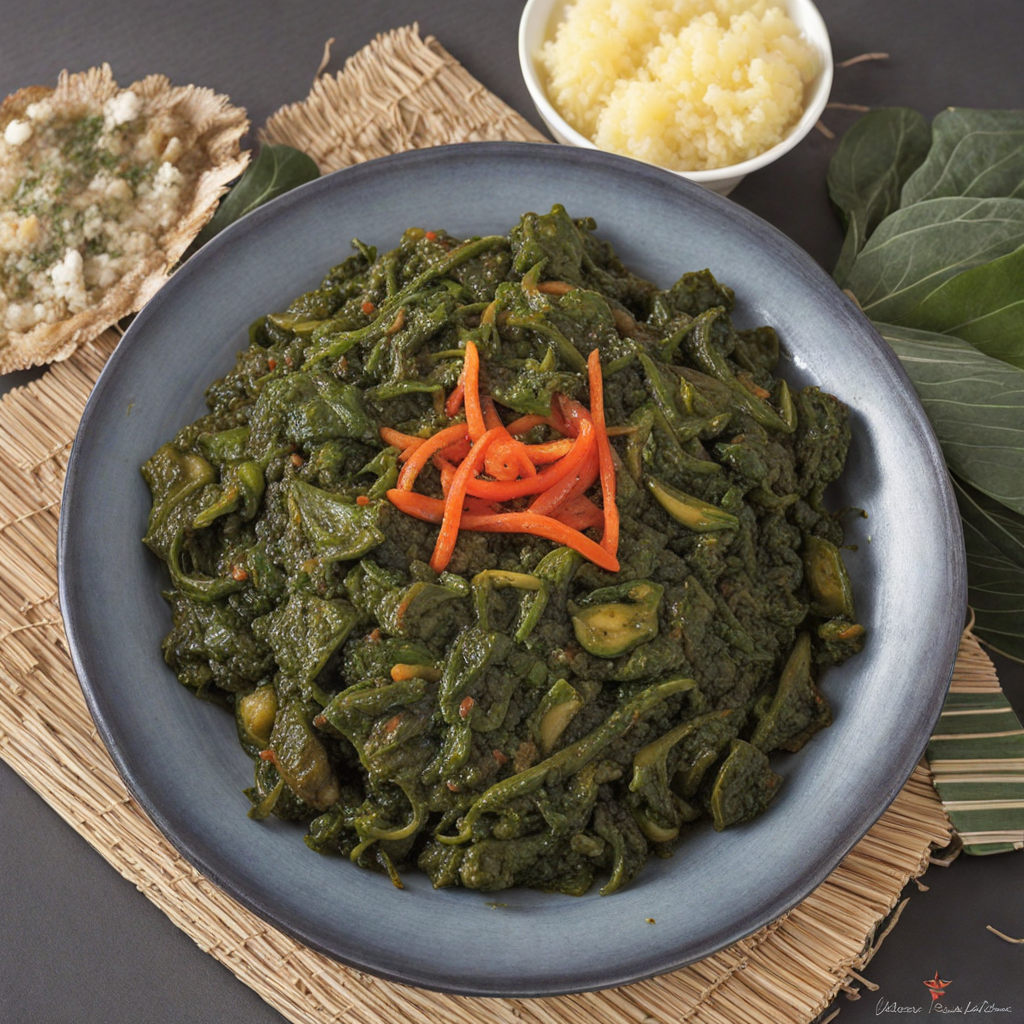Pom
Pom is a delightful and unique dish that showcases the rich culinary heritage of Suriname, a country known for its diverse cultural influences. At its core, Pom is a casserole made primarily from grated pomtayer, a starchy root vegetable similar to taro, which lends the dish its name. The pomtayer is mixed with a medley of ingredients, including marinated chicken, which is often seasoned with a blend of spices and citrus, creating a savory and slightly tangy flavor profile. The combination of the tender chicken and the earthy pomtayer results in a comforting dish that is both hearty and satisfying. One of the defining characteristics of Pom is its layered texture. Once assembled, the dish is baked until the top is golden and crispy, while the interior remains moist and flavorful. This contrast in textures adds to the overall experience, making each bite a delightful journey. The dish is often served with a side of salad or plantains, providing a refreshing balance to the richness of the Pom. Additionally, some variations include the addition of other vegetables or even fish, showcasing the versatility of this beloved Surinamese recipe. Pom is more than just a meal; it is a cultural staple that is frequently prepared for special occasions and family gatherings. The act of making Pom often brings families together in the kitchen, where generations share techniques and stories. When you taste Pom, you are not only savoring a delicious dish but also experiencing a piece of Suriname's vibrant history and its culinary fusion of indigenous, African, and European influences. Each bite reveals layers of flavor that speak to the heart of Surinamese culture, making it a must-try for anyone looking to explore new and exciting tastes.
How It Became This Dish
Pom: A Culinary Journey from Suriname #### Origins Pom, a beloved dish from Suriname, is a testament to the country's rich cultural tapestry. Suriname, a small nation on the northeastern coast of South America, boasts a diverse population composed of various ethnic groups, including Indigenous peoples, Africans, East Indians, Javanese, and Chinese. The origins of Pom can be traced back to the 17th century when the Dutch colonized Suriname. They brought enslaved Africans to work on sugar plantations, leading to a fusion of culinary practices that would shape the nation’s future food landscape. The core ingredient of Pom is the pomtajiri, also known as the "pomelo" or "citrus maxima," which is a large citrus fruit native to Southeast Asia. The fruit was brought to the Caribbean by early European settlers, and its versatility made it a staple in many local dishes. Over time, the pomelo was incorporated into the creation of Pom, which is often made with chicken or fish, along with a hearty mix of vegetables, spices, and the crucial element of the pom fruit itself. The dish has evolved from its simple beginnings into a complex and beloved symbol of culinary heritage in Suriname. #### Cultural Significance Pom is more than just a dish; it embodies the cultural identity of Suriname. It is often served during significant family gatherings, celebrations, and holidays, such as Keti Koti, which commemorates the abolition of slavery in 1863. During these events, Pom serves as a centerpiece, a dish that brings families together and evokes memories of shared history and tradition. The preparation of Pom is often a communal affair, with families gathering to cook and share stories. This communal aspect underscores the importance of family and togetherness in Surinamese culture. The dish is often accompanied by rice and various sauces, reflecting the mixing of culinary influences that characterize Suriname’s diverse population. Each ethnic group has its own unique take on Pom, showcasing the adaptability and creativity inherent in Surinamese cuisine. In addition to its role in family gatherings, Pom is also a dish that signifies hospitality. It is common for Surinamese families to serve Pom to guests, symbolizing warmth and welcome. This practice illustrates how food in Suriname serves not just as sustenance but as a means of building and reinforcing social bonds. #### Development Over Time The evolution of Pom reflects Suriname’s dynamic cultural landscape. Initially, Pom was a dish prepared primarily by the Creole community, incorporating elements from African culinary traditions and local ingredients. However, as Suriname became a melting pot of cultures, Pom began to absorb influences from other ethnic cuisines. In the 20th century, the arrival of Javanese and Chinese immigrants introduced new flavors and ingredients to Pom. Javanese spices and techniques, such as the use of soy sauce and sambal, began to find their way into the dish, adding layers of flavor and complexity. At the same time, Chinese cooking methods and ingredients, like wok-fried vegetables and various sauces, further enriched the Pom experience. The dish’s adaptability has allowed it to thrive in modern Surinamese cuisine. Today, Pom is often made with alternative proteins, such as shrimp or tofu, catering to changing dietary preferences and the growing vegetarian and vegan movement. These variations maintain the essence of the dish while allowing for creativity and innovation in the kitchen. In recent years, Pom has gained recognition beyond Suriname's borders, particularly in diaspora communities. Surinamese immigrants have taken their culinary heritage with them, introducing Pom to new audiences in countries such as the Netherlands, the United States, and Canada. This globalization of Pom has resulted in a growing appreciation for Surinamese cuisine, with restaurants and food festivals showcasing the dish and its cultural significance. #### Cooking Pom: A Traditional Recipe To truly appreciate Pom, one can delve into its preparation. Traditionally, Pom is created by layering cooked chicken (or another protein) with a mixture of grated pomelo and various spices. The dish is typically baked until golden and bubbling, allowing the flavors to meld beautifully. Here’s a simplified recipe to give you a taste of this beloved dish: Ingredients: - 1 kg chicken (or tofu for a vegetarian option) - 4 cups grated pomelo (or pomtajiri) - 2 onions, finely chopped - 3 cloves garlic, minced - 2 tablespoons soy sauce - 1 tablespoon sambal (chili paste) - 1 teaspoon nutmeg - Salt and pepper to taste - 2 tablespoons vegetable oil - Fresh herbs (like parsley or cilantro) for garnish Instructions: 1. Preheat the oven to 180°C (350°F). 2. In a large skillet, heat the vegetable oil over medium heat. Sauté the onions and garlic until translucent. 3. Add the chicken (or tofu) and cook until browned. Stir in the soy sauce, sambal, nutmeg, salt, and pepper. 4. In a greased baking dish, layer half of the grated pomelo, followed by the chicken mixture, and then top with the remaining pomelo. 5. Cover with aluminum foil and bake for about 45 minutes. Remove the foil and bake for an additional 15 minutes until golden. 6. Serve hot, garnished with fresh herbs, alongside rice and your favorite sauce. #### Conclusion Pom is a dish that encapsulates the essence of Surinamese culture — a blend of history, community, and innovation. Its evolution reflects the intermingling of various ethnic traditions, each contributing to a unique culinary heritage. As Pom continues to gain popularity both in Suriname and abroad, it serves as a reminder of the importance of food in connecting people to their roots, bridging cultural divides, and fostering a sense of belonging. Whether enjoyed at a family gathering or a festive celebration, Pom remains a cherished part of Surinamese identity, inviting all who partake in its flavors to share in its rich history.
You may like
Discover local flavors from Suriname







